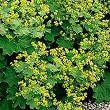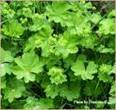| Kingdom | Plantae |
| Division | Magnoliophyta |
| Class | Magnoliopsida |
| Order | Rosales |
| Family | Rosaceae |
| Genus | Alchemilla |
| Species | A. vulgaris |
| Binomial name | Alchemilla vulgaris |
Other Common Names:
The other common names herb ladies mantle are Leontopodium, Stellaria,Lion's Foot, Bear's Foot, Nine Hooks, Alchemillaeherba, Ellagicacid, Flavonoids, Frauenmantle, Frauenmantelkraut, Ladies cloak, Leontopodium, Pied-de-lion, Quercetol, Quercetin, Stellaria and Tannins.
History
Ladies mantle was named in the 16th century by Jerome Bock, also known as Tragus, and it appears under his name in the book History of Plants, published in 1532. It has a time honored traditional use as a women's healing herb. The name Alchemilla, comes from the Arabic 'alkemelych', alchemist, bestowed by olden writers because of the wonder-working powers of the plant. The plant called the lady's mantle is called Alchemilla vulgaris, in botanical circles.


The plant is of graceful growth and though only a foot high and green throughout- flowers, stem and leaves alike, and therefore inconspicuous - the rich form of its foliage and the beautiful shape of its clustering blossoms make it worthy of notice.
Description
Ladies mantle is a perennial plant which grows upto 18 inches high. The stem is erect and is initially green or blue-green and later turning to reddish or brownish. The whole plant is clothed with soft hairs. The lower leaves are radical 6 to 8 inches in diameter borne on slender stalks. They are palmate and are 7 to 9 lobed and finely toothed thus getting the name nine hooks. The upper leaves are similar and either stalks less, or on quite short footstalks and are all actually notched and toothed.


Range
The Lady's Mantle is natives of the American Andes and other parts of continental Europe. It is also distributed in North America and Northern and Western Asia. The Common Lady's Mantle is generally distributed over Britain, but more especially in the colder districts and on high-lying ground, being found up to an altitude of 3,600 feet in the Scotch Highlands.
Habitat
It prefers a habitat of pastures, damp places and shady woods.
Cultivation
The seeds of the lady's mantle will germinate in the garden, but will take up to 2 years to flower. It will grow from 6 inches for the alpine variety to about 12-18 inches on the others. Space about 12 inches between plants is required. Lady's Mantle needs a fertile soil and some moisture-more than the standard herbs. It can be in full sun in northern climates, but can tolerate some shade and in the warm climates prefers it. Lady's Mantle can be invasive if left to seed. But the flowers can be dried and used in crafting, so it is harvested before they form seed. The harvesting of the lady's mantle occurs during the summer months.
Flowering Season
The flowers of the lady's mantle are in bloom between late spring to early summer.
Pests and Diseases
A yellow fungus sometimes attacks the plant known as Uromyces alchemillae, and has the curious effect of causing abnormal length of the leaf-stalk and rendering the blade of the leaf smaller and of a paler green colour.
Parts Used
Generally the roots and the aerial parts of lady's mantle are of medicinal and commercial use. The root is sometimes also employed, generally fresh. However most of the time the whole herb is of use.
Medicinal Applications


• Lady's mantle has been used for a variety of female conditions such as menstrual disorders including excessive menstruation and menopause, great improvement in the regularity of the menstrual cycle, as an aid during conception, in the prevention of miscarriages, and to help the body heal after childbirth.
• The Lady's Mantle has astringent and styptic properties; on account of the tannin it contains and helps in the treatment of wounds.
• Lady's Mantle is very proper for inflamed wounds and to stay bleeding, vomiting, fluxes of all sorts, bruises by falls and ruptures.
• A strong decoction of the fresh root, is recommended stop all bleedings and for violent purgings.
• A tincture of the leaves has been given in cases of spasmodic or convulsive diseases.
• It is used to bring relief from vomiting and nauseous sensations.
• The major belief of the early herbalists regarding the lady's mantle was that this herb was possessed of such strong contractile powers, that it was though capable of "restoring" lost virginity to women and was believed to bring on a new firmness to flabby breasts in older women.
• The herbal remedy made from the lady's mantle is also often prescribed for the treatment of conditions like fibroids and endometriosis in women.
• The herbal extract is also often used as a douche to wash off excess vaginal discharge and bring rapid healing.
• The herbal remedy made from the lady's mantle is believed to act as a liver decongestant and it is said to facilitate the birth of a child.
• The treatment of diarrhea and gastroenteritis is hastened by the astringent properties of the herb.
• The herb induces a rapid reduction in the inflammation affecting the digestive system as well as the reproductive system of patients.
• The herbal lady's mantle decoction can also function as an excellent skin lotion for the treatment of rashes in diseases such as eczema.
• The herbal decoction can also be used as a mouthwash and gargle in cases of bleeding gums, to treat mouth ulcers and to minimize the symptoms of sore throats in patients.

The herb lady's mantle is related with the Virgin Mary because of the lobes of the leaves being supposed to resemble the scalloped edges of a mantle. It is also called as Leontopodium (lion's foot), probably from its spreading root-leaves, and this has become in modern French, Pied-de-lion. It has also been called 'Stellaria,' from the radiating character of its lower leaves.

This herb was associated with the Virgin Mary in the Middle Ages and the lobed leaves resemble the scalloped edges of a cloak or mantle, as worn by the Virgin in medieval paintings. The 'lady' element may refer to the herb's value in treating female disorders. The generic name 'alchemilla' is due to the wonderful way in which dew drops are held in the leaves of the plant. These magical droplets, believed to be imbued with the powers of the herb. Tradition states that if placed under the pillow at night the herb will promote a good night's sleep.